Growth and impact. These are the two fundamental words that show what a successful direct selling organization looks like. Growth signifies expansion and progress, while impact reflects the positive influence direct selling companies has on the world. At the heart of achieving both lies these questions;

What are the objectives of their growth strategy?

Which of their products or services contribute to the growth?

What markets or customer segments do they target, and which ones are not in focus?
From this point forward, we at Epixel set out to identify the factors contributing to the growth of the leading direct selling companies. By analyzing their growth strategies, growth factors, and investment areas, we designed an insightful guide to help direct selling businesses navigate challenges and drive long-term success in the global market.
Research objective
Our main objective is to understand the key strategies that successful direct selling companies use and the factors that contribute to their growth. This information can be valuable for new and established direct selling businesses, as well as aspiring entrepreneurs looking to adapt, grow, and succeed in a rapidly changing market.
Research methodology
The data was collected manually from the annual reports, official website press releases, and other industry reports of the top 10 direct selling companies.
Report snapshot
This overview gives a quick reference to the main areas covered in our comprehensive study:

1. Direct selling growth: Assessing the documented growth patterns of the top direct selling companies.
2. Growth strategies: Analyzing the strategies and approaches direct selling companies employ to drive and sustain their growth.
3. Growth factors: Exploring the crucial factors that contribute to the growth and success of these leading direct selling companies.
4. Product segments and regional contribution: Understanding which product segments and geographic regions play the most significant roles in their revenue growth.
5. Key investment areas: Analyzing the primary areas of investments that potentially drive the growth of direct selling companies.
Year-over-year direct sales companies' growth
Let's take a quick look at the direct sales market's performance over the past few years (2018-2023). The table below shows the revenue in millions for each year. This data will be our starting point to understand growth trends and identify any interesting shifts:
| Year | Revenue (in millions) |
|---|---|
| 2018 | $108,117 |
| 2019 | $110,067 |
| 2020 | $122,238 |
| 2021 | $128,769 |
| 2022 | $125,175 |
| 2023 | $123,972 |
Source: Businessforhome
A report from Statista shows that the direct selling industry in the US has been steadily growing over the past few years. By looking closely at the chart, we can spot years with big growth jumps. These peaks, especially in 2022 and 2023, might reveal specific events or trends that caused the industry to grow quickly.
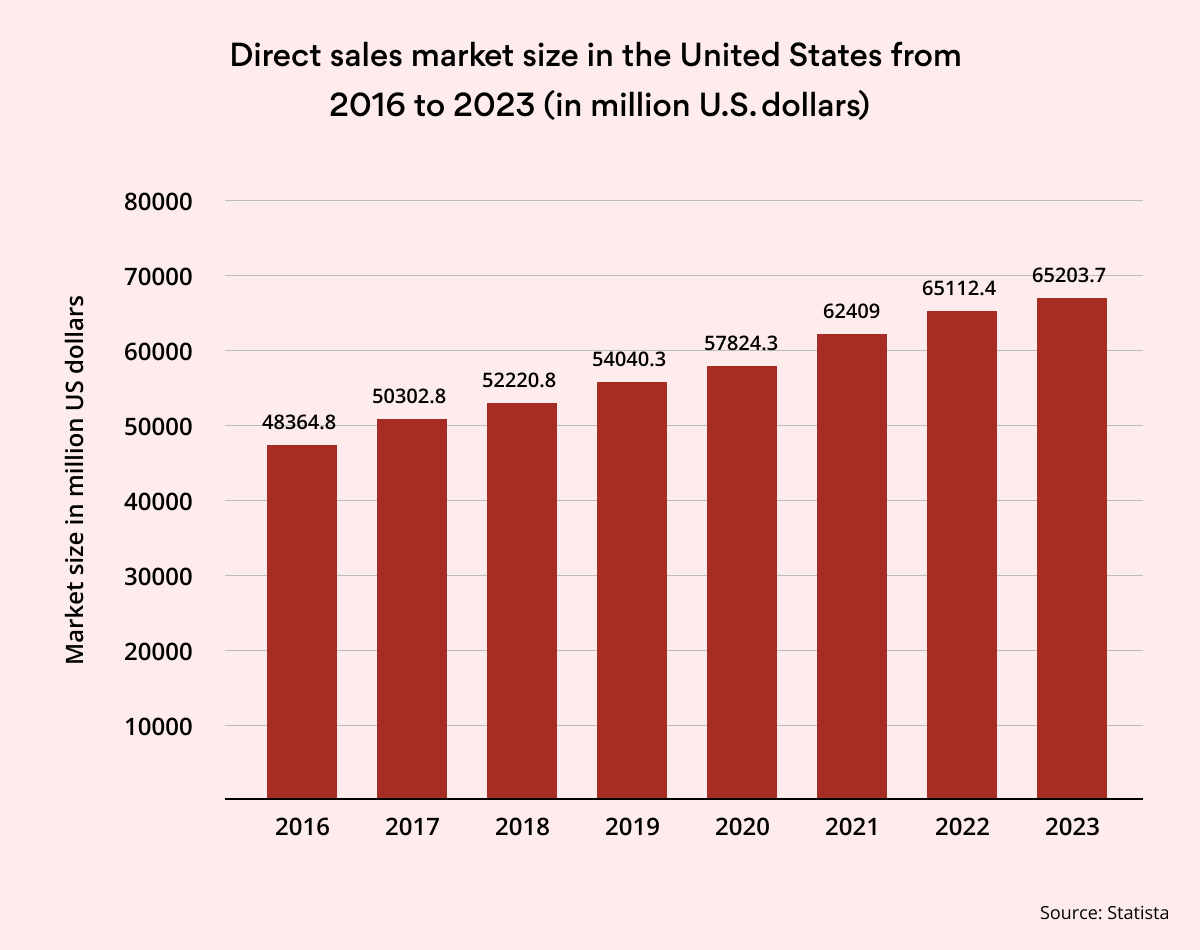
While the graph offers a valuable snapshot of the overall growth trend in the US direct selling market, a more comprehensive analysis would be necessary to identify the specific strategies employed by leading direct selling companies for achieving growth within this dynamic industry.
Proven growth strategies for direct selling success
Learning to grow in a business environment depends on having a well-defined growth strategy. To understand this better, we looked into the high-performing growth strategies of top direct selling companies.
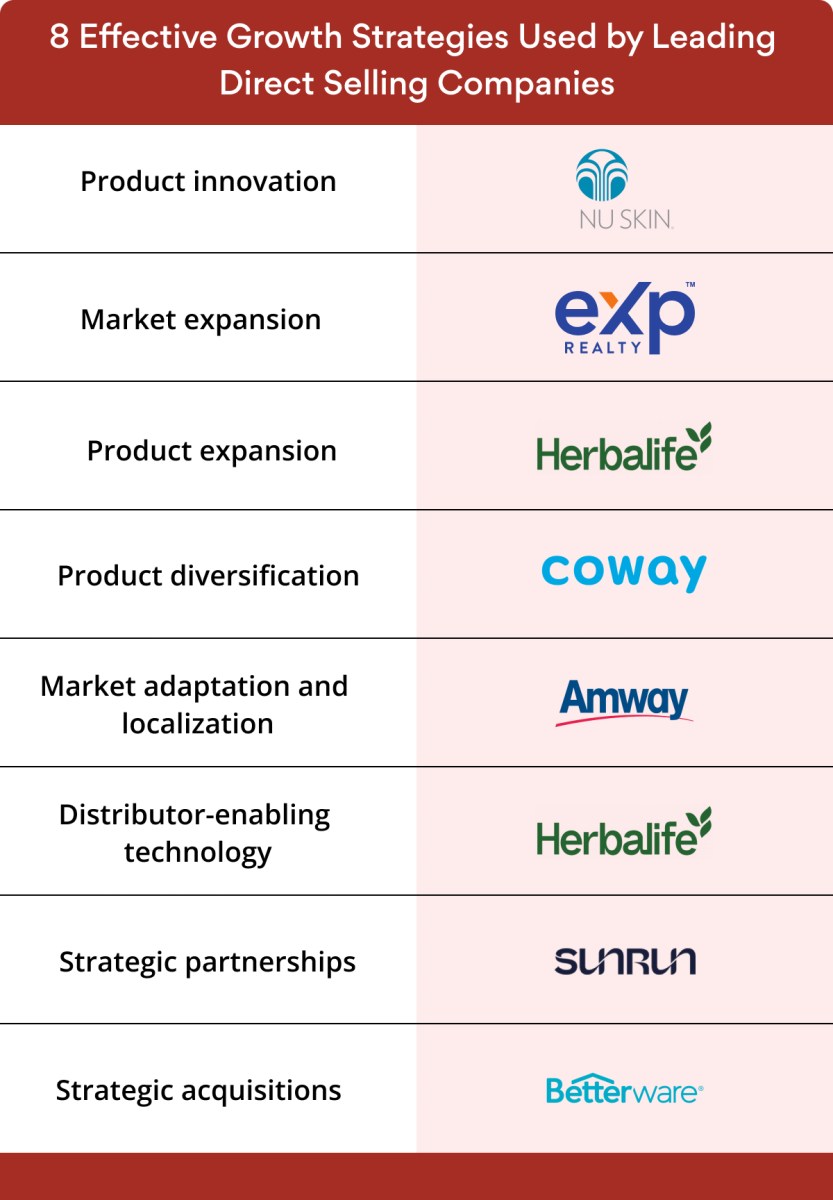
1. Product innovation
The concept of product innovation refers to new releases, but the term can also be used to describe incremental updates to existing products or services as well as development of new product features. Product innovation is necessary for growth. And since technology is moving fast and customer needs evolve faster, it's important to continually innovate the product so that it stays relevant and essential.
Example: Nu Skin growth strategy

Example: Nu Skin growth strategy
Nu Skin is known as the top brand for Beauty Device Systems worldwide, which is a big part of their strategy. In the wellness category, their plan is to keep bringing out new and proven nutritional supplements, backed by research, development, and high-quality manufacturing. In 2023, Nu Skin launched the ageLOC WellSpa iO, a new beauty device promoting overall wellness. These smart devices, when used with their mobile app, gather data on consumer behavior for more personalized experiences. One such product is the ageLOC TRMe, a personalized weight wellness line.
Key insights:
Brand leadership: Nu Skin has established authority in the wellness industry. They keep an eye for consistently delivering high-quality products, building and maintaining robust customer relationships, and communicating their brand values clearly and effectively.
Data-driven personalization: Utilizing data insights is another step forward. Data has helped them personalize their offerings to meet each customer's unique preferences and needs.
Growth opportunities: By combining the above two factors, ongoing innovation, and staying up-to-date with the trends happening around has helped Nu Skin capitalize on growth prospects and thus securing their spot for long-term success.
2. Market expansion
A dynamic growth strategy, market expansion helps direct selling businesses find new avenues to sell their offerings, reach more customers, and make the business more profitable. This expansion might focus on establishing a presence in new regions or forming strategic partnerships.
Example: eXp Realty growth strategy
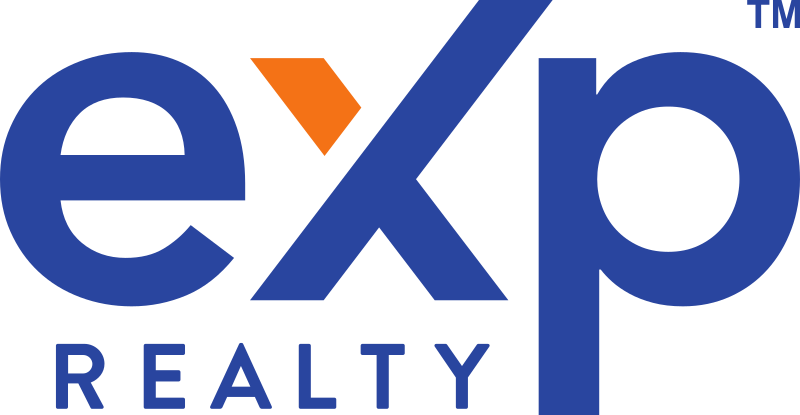
Example: eXp Realty growth strategy
eXp Realty’s growth strategy focuses on growing organically in the North American and certain international markets by bringing more independent agents and brokers on board. In 2023, the company’s objective was to achieve operational excellence. They used the agent Net Promoter Score (aNPS) to monitor and measure the impact and it played a big part in attracting and retaining agents. The company also implemented a series of strategic initiatives Boost, Thrive, Accelerate, and Masterminds that led to a 2% increase in agent count despite tough market conditions.
Key insights:
Agent and broker network expansion: Focusing on the growth of their independent agent and broker network has helped eXp Realty strengthen its market position and increase its reach.
Market share expansion: They used their technology platform to improve customer service, increase market share, and achieve strong returns as they grew their business within the markets they operate.
Strategic partnerships and investments: By building partnerships and strategically investing money, eXp Realty has aimed to grow their business and enter attractive new markets and sectors.
3. Product expansion
A product expansion strategy is all about expanding a company's product line or introducing new products to attract both existing and potential customers. This means developing new products or improving current ones to meet diverse customer needs and preferences. The aim is to increase sales and bring in new customer segments by offering a wider selection of products.
Example: Herbalife growth strategy

Example: Herbalife growth strategy
Herbalife has moved beyond its weight-management origins. They have now made a science-backed product portfolio with a combination of their core line, clean label or non-GMO options to satisfy both global consumer trends and local preferences. In Q1 2023, the company launched 106 new wellness products in 95 markets. Their Formula 1 Nutritional Shake Mix became the best-selling product line, approximately 26% of the net sales by year-end.
Key insights:
Increased customer loyalty: Herbalife keeps its customers happy and helps them find what they need by offering more products that meet current health trends and this makes them more likely to stick with the brand.
Enhanced brand visibility: The extensive rollout of new products and entering new markets shows Herbalife's commitment to innovation and adaptation to local preferences. This approach also makes the brand more recognizable and appealing to a wider audience.
High competitive advantage: This approach differentiates Herbalife from its competitors and also helps the brand stand out as a leader in the health and wellness industry.
4. Product diversification
Product diversification is a business strategy where a company adds new and different products to its lineup, often in entirely new categories beyond its usual offerings. This may sound similar to product expansion as we discussed above—improving or adding to existing products, diversification emphasizes branching out into new areas. This approach can help companies grow, especially in mature markets where competition is strong and growth opportunities are limited.
Example: Coway growth strategy

Example: Coway growth strategy
As a part of their product diversification strategy beyond their water purifier, Coway successfully launched a new brand, BEREX. Coway’s BEREX Reclining Massage Bed focuses on delivering sleep and relaxation benefits. It also comes with an integration of product categories—mattresses and massage chairs to improve relaxation. BEREX has also won CES 2024 Innovation Award in Digital Health category. In the near future, Coway is all set to establish sleep and healing care as a new growth engine through BEREX.
Key insights:
Strategic branding: Creating the BEREX brand for their new product line allows Coway to establish a distinct identity in the wellness market which is separate from their established presence in the water purifier industry.
Market differentiation and recognition: Coway’s new launch has made the brand a pioneering force in the trending sleep and wellness business. They have also earned recognition for their innovation, thereby establishing a strong foothold in a new and growing market segment.
Expanding market presence: BEREX's visionary approach on sleep and healing care positions it as Coway's new growth engine and reflects the company's strategic, long-term investment in the health and wellness sector.
5. Market adaptation and localization
Adaptation strategy translates into tailoring the marketing mix (4Ps)—product, price, place, and promotion—to be locally relevant to diverse global consumers. This strategy is commonly employed by mid to large-sized enterprises when they aim to expand into a foreign market.
Example: Amway growth strategy
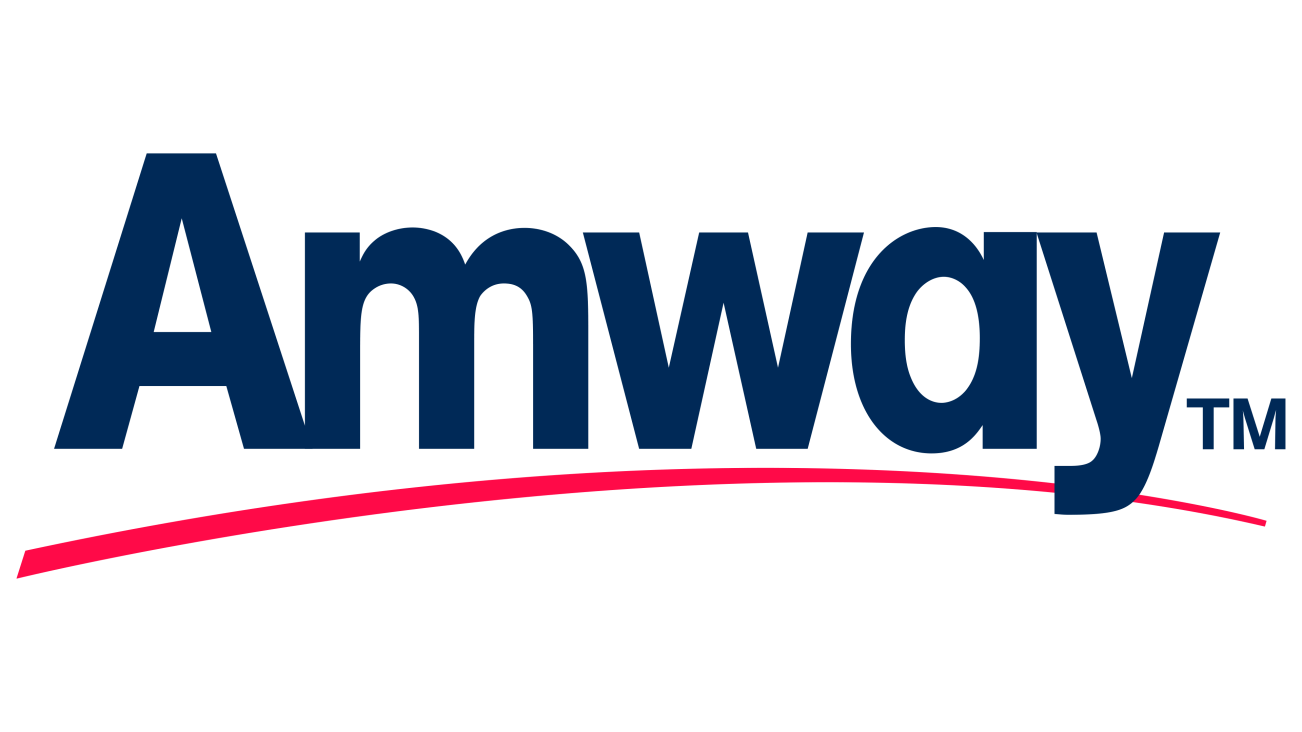
Example: Amway growth strategy
Amway's new "Beautiful Life" strategy is a part of their growth objectives by targeting China, their biggest and fastest-growing market for the last twenty years. In this approach, Amway China is shifting its attention to health and wellness, following the State Council’s “Healthy China” blueprint. The strategic focus also extends to include emotional well-being, social connections, and financial security, aligning with evolving consumer demands.
Key insights:
Market prioritization: By targeting mlm in China, Amway has allocated resources where the company can see the greatest potential for growth and revenue generation.
Adaptation to local trends: Their new "Beautiful Life" strategy highlights Amway's responsiveness to shifting consumer preferences in China.
Diversification of strategic focus: Their holistic approach suggests a deeper engagement with consumers and a commitment to addressing their multifaceted needs.
6. Distributor-enabling technology
Distributors form the part and parcel of any direct selling business and so they are the key drivers when crafting a growth strategy. In here, a distributor-enabling technology helps distributors ease their tasks by providing them with the technological tools and resources they need to work more productively on the core activities.
Example: Herbalife growth strategy

Example: Herbalife growth strategy
A second leg of Herbalife’s growth strategy is investing in distributor-enabling technology. ‘HN MyClub’ and ‘Engage’ are their two apps which enable distributors to connect seamlessly with customers by providing them with a mobile-first experience. It’s easy to use for new and existing customers where they can learn more about the Herbalife’s Nutrition club, read reviews and place orders.
Key insights:
Distributor scalability: Implementing front-end technology allows distributors to increase their reach and productivity without compromising quality or performance.
Increase distributor-to-customer connectivity: Tech can never replace distributors but can support them by managing the business more efficiently and freeing up their time so they can concentrate on building meaningful and personal relationships with customers.
Enhance customer experience: Allows distributors to focus more on high value interactions with their customers, give them high touch experiences, and strengthen the unique value they bring into their organizations. This can lead to more sales and sustainable businesses.
7. Strategic partnerships
Strategic partnerships involve collaborating with other companies in related industries to expand the business’s operations. This could involve teaming up for projects, co-branding, or forming close ties. These partnerships offer quick access to new products, technologies, or customer bases. This strategy can work great for businesses wanting to break into new markets or expand their product offerings.
Example: Sunrun growth strategy

Example: Sunrun growth strategy
Sunrun, the top provider of clean energy through subscription services, teams up with Lowe’s, a global home improvement retailer, to offer solar and storage services within hundreds of Lowe’s stores across the country. Sunrun has introduced initiatives such as renewal pilot, battery retrofit, and standalone storage to enhance customer value, build long-term relationships, and expand their reach. So, this new retail partnership opens up new avenues for growth.
Key insights:
Deep partnership experience: Sunrun's strong partnerships make it the go-to choice for new players in the growing industry.
Capital efficient growth: Working together with partners helps Sunrun streamline market entry and exit strategies, cut down costs for acquiring new customers, and makes solar more accessible.
Customer base expansion: Leveraging established partner networks, Sunrun effectively extends its reach to new segments of solar customers.
8. Strategic acquisitions
Strategy explanation: Part of broader business goals, an acquisition strategy is when one company buys another to gain immediate access to new markets, customer segments, or product lines. The basic idea here is that by combining, they can work better together—this is called synergy. It's like saying 1 + 1 equals 3 because the merged company is more valuable and effective than the two on their own. This approach can speed up growth when compared to the gradual process of organic expansion.
Example: Betterware growth strategy

Example: Betterware growth strategy
Betterware made a bold move in 2022 by acquiring Jafra Cosmetics International, Inc. This ‘Jafra acquisition strategy’ gave them instant access to the Mexican beauty market, expanding their offerings beyond household products. With Jafra's lineup of over 1,200 beauty and personal care items, it opened up opportunities for more growth in both the U.S. and Mexico.
Key insights:
Steady growth: This strategic move allowed Betterware to sustain steady growth by tapping into new revenue streams and reducing dependency on a single market segment.
Financial stability: By diversifying their product offerings, Betterware is capable enough to withstand market volatility and economic uncertainties with greater financial strength.
Enhanced performance: Jafra's success in Mexico helped Betterware become more adaptable to market changes, which directly contributed to their growth.
Find out from our customers how our solutions give MLM businesses an edge and exceed customer expectations
Factors contributing growth of leading direct selling companies
In the coming years, with advancements in technology and shifts in consumer preferences, the direct selling market may witness new opportunities for growth. But is this the whole story? We've reached the next stage of our research with this—to identify the primary factors that play a major role in the remarkable growth of these leading direct selling companies.
Let’s read the details now.
1. Richer product mix and marketing efforts
Natura &Co.'s impressive financial results showcase the success of a strategic shift. Their growth strategy prioritizes profitability and also emphasizes integrating Avon and Natura brands in Latin America to leverage a unified presence.
Natura &Co. saw a 6.4% increase in revenue, mainly due to strong sales of the Natura brand in Brazil.
Alongside, the gross margin improved significantly, rising to 63.8%. This was due to their focus on selling:
- Higher-margin products: Realigned their metrics to offer a wide range of products that address the pressing concerns of a broader customer base.
- Effective marketing strategies: For instance, Natura’s Avon advanced its omnichannel strategy in the UK by teaming up with Superdrug, a key high-street retailer with more than 830 outlets that led to higher sales of profitable products.
2. Rise of online consumer purchasing behaviors
Nu Skin is buzzing about the outstanding growth of their Rhyz segment, which is their strategic investment arm focusing on innovation in beauty, wellness, and lifestyle. Rhyz experienced over 100% growth and contributed 13% to Nu Skin’s revenue in the fourth quarter.
Rhyz made up 11% revenue in 2023 and this is expected to grow to 25% by 2025.
The growth is driven by their:
- Enhanced social commerce capabilities: With more and more consumers opting for online shopping, Nu Skin is showing how it stays in tune with market shifts. They're investing in MLM ecommerce solutions to grab a bigger piece of the online market pie.
- More personalized approach: Rhyz is playing a bigger role in satisfying end users as they achieve desired results with its personalized approaches. For example, WellSpa iO is a strong addition to their top beauty device system and is generating consumer interest with its proven results.
3. Digital transformation
Herbalife puts a spotlight on the tech side of things. In their vision, a robust technology infrastructure sustains, protects, and improves current systems and facilitates the development of new ones to support their growth. So, they're on top of evolving industry and regulatory standards, emerging data security risks, and changing consumer patterns and preferences.
The growth is driven by their:
- Leveraging business intelligence tool: These tools allow for deeper analysis of their business, helping them spot growth opportunities. With these handy tools, Herbalife can tap into global technological advancements to enhance both distributor and customer experiences.
- Investing in transformation program: In 2021, the company initiated a global transformation program to optimize their global operations for future expansion. This involves investing in new technologies and restructuring infrastructure and function locations to provide improved support for distributors and customers.
4. Strong base of agent support
For eXp Realty, having strong agent support is essential for growth. Since their business depends on home sales transactions and prices, economic ups and downs can affect them. Factors such as economic growth, interest rates, employment, consumer confidence, mortgage availability, and supply and demand are all influenced by market conditions and industry trends.
eXp Realty has grown to 80,000 agents from 53,379 in 2021, making it the top-performing global real estate brokerage.
Happy and productive agents are more likely to stay loyal to the company and increase their sales which drives organic market share growth, retention and productivity. And so, eXp Realty has more in their store for providing robust agent support with:
- Cloud-based brokerage: The digital nature of eXp Realty gives it a strong advantage over brick-and-mortar real estate companies, which allows the company to share its profits with its agents.
- Efficient operating model: It's a low-cost, high-engagement model that gives agents and brokers more income and ownership opportunities. At the same time, it offers a scalable MLM solution for brokerage owners looking to succeed during economic changes.
5. Ongoing value delivery
Customer value is the cornerstone of Utility Warehouse’s (UW) growth and success story. They make it a point to continuously demonstrate and deliver value to their customers with competitive prices, quality service, and added benefits. This approach keeps existing customers loyal and brings in new ones, ensuring steady growth.
UW has seen record organic growth in its operations, including a 22% increase in customers.
UW provide real value to their customers by offering guaranteed savings on their energy bills and also cashback card savings across all their home services. And they continue to deliver value with their:
- Multiservice bundles: UW now offers more than three million services—energy, broadband, mobile, and insurance, to over one million UK households. Bundling these services into one bill allows customers to save significantly on their monthly payments.
- Lowest energy prices: UW’s customers benefitted from the lowest energy prices in the country throughout the year.
6. Proprietary tools and technology
Primerica takes the crown as the largest independent financial services marketing organization in North America and has 90,000 licensed representatives across all 50 states. Their push for Primerica online subscriptions saw a rapid rise from around 10-20,000 subscribers to a whopping 90,000 in a blink.
Global direct selling market to grow at a CAGR of 5% during 2024-2032 and is driven by rising adoption of advanced technologies by players.
Primerica has always been keen on providing tech solutions for their sales team. And so, their focus is on proprietary tools and technology for attaining growth.
- Simplifying operations: Primerica's tools streamline administrative tasks for distributors and agents, freeing up more time for sales, recruitment, and training efforts. This leads to a boost in sales growth.
- Proprietary digital sales tools: These tools also allow representatives, including Primerica top earners, to work productively anywhere and anytime. They provide efficient and secure electronic applications with automatic prompts to reduce errors.
7. Scalable operating platform
From the get-go, Sunrun has been all about investing in a platform of services and tools to make their large-scale operations run smoothly. This covers everything from processes and software to fulfillment and acquisition of marketing leads. With this MLM enterprise platform, they can tap into diverse distribution channels, reaching a wider audience through partners and direct-to-consumer operations, and attracting new customers effortlessly.
Sunrun has achieved over 25% year-over-year growth in Solar Energy Capacity.
After the invention of their residential solar service model and recognizing its enormous market potential, Sunrun has come up with the infrastructure and capabilities to rapidly acquire and serve customers in a cost-effective and scalable manner. Sunrun’s scalable operating platform provides a number of unique advantages:
- Multi-channel model support: They expanded distribution by marketing their solar service offerings through multiple channels. Apart from broad sales, the model also supports installation capabilities, which together allow them to achieve capital-efficient growth.
- Meaningful margin advantages: By delivering exceptional customer experiences, Sunrun aims to achieve significant margin advantages in the long run. Their goal is to build the industry's most valuable and satisfied customer base.
8. Business intelligence and technology units
Thanks to its asset-light business model and three strategic pillars—Product Innovation, Business Intelligence, and Technology—today Betterware has achieved sustainable double-digit growth rates. They've successfully expanded household penetration and share of wallet, all while leveraging state-of-the-art technology tools for data-driven insights, guiding their product development, and other such marketing strategies.
Today, Betterware holds a 24% household penetration rate in Mexico and a 20% share of wallet in the industry.
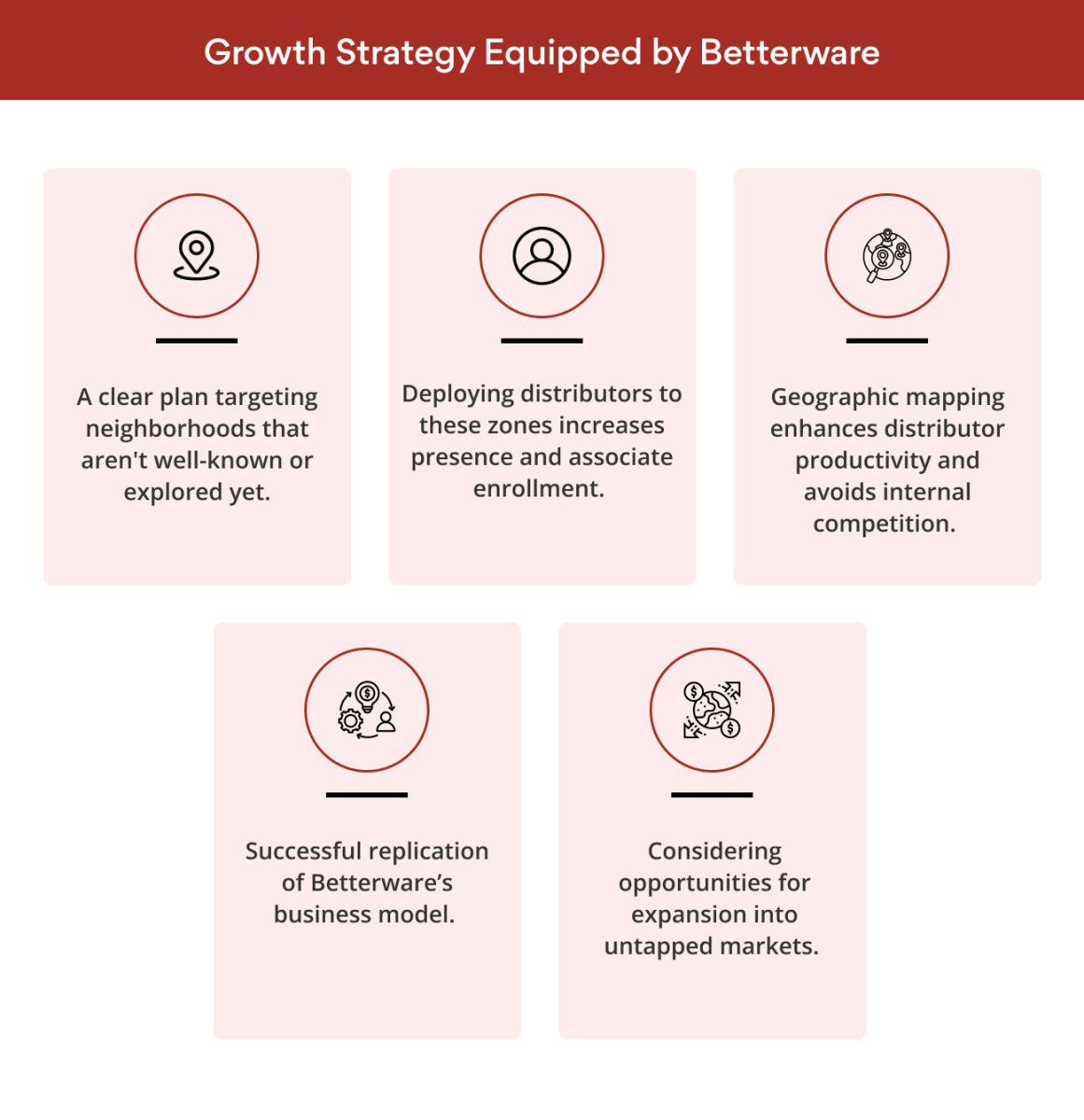
Betterware is all set to expand and strengthen the digitalization of their business strategy with best-in-class technological tools:
- Product intelligence: Extensive product analysis to track performance, instant market reactions, and identify markets that align with their business model. Their strategy is all about creating highly competitive and innovative products. By providing their distribution network with high-quality products, they attract new customers.
- Tight monitoring: Proprietary live performance tracking platform monitors weekly performance against sales objectives. This platform also offers detailed insights into each distributor's number of orders, average ticket, item types, and more. They can modify objectives based on real-time performance data.
9. Customer loyalty
Nu Skin's rewards program is tailored for retail customers and members. The brand utilizes subscription and loyalty programs that incentivize repeat purchases which offer benefits like convenience and potential cost savings. All purchases under these programs follow their standard payment and return policies.
Nu Skin is one of the leading direct selling companies in the United States, which generated a revenue of around $2.8 billion in 2022.
By simplifying product access and rewarding repeat business, Nu Skin builds stronger relationships, improves retention, ensures a steady revenue stream, and increases customer lifetime value.
- Product subscription: Ensures regular, hassle-free deliveries and attractive pricing, which fosters repeat purchases.
- Loyalty programs: Features the best subscription pricing, vouchers with attractive discounts, and subscriber benefits such as product samples and discounted shipping. Nu Skin effectively retains customers and encourages them to try new products.
10. Unique multiservice proposition
Utility Warehouse, the consumer-centric brand of Telecom Plus, has a unique business model that offers different services like electricity, gas, internet, phone, and insurance. The company has over a million customers across the services it sells and bundles all these services into one bill to make it cheaper for them.
UW records historic performance driven by a 20% annualized increase in its customer base.
The convenience UW offers along with their products, scope for potential cost savings, and large untapped market all support their growth strategy. The brand is confident these factors will continue to strengthen their position:
- Competitive position: UW is a crowd puller as it offers bundled services with competitive pricing and excellent customer service.
- Strong organic growth: The company meets with growth by attracting and retaining customers through cost savings and a hassle-free experience.
Product segments and regional growth contributions
Let’s pause for a moment and look around to notice how there’s a growing demand for direct selling business. This could be due to rising incomes, a greater focus on health and beauty, and an expanding middle-class population. But is the impact the same across all regions?
Before you start brainstorming and digging into research, we've got you covered right here. Stay with us, because we're about to discuss the unique offerings of each direct selling business and the regions where they're making their impact known.
Amway
Product: Nutrilite vitamins and dietary supplements are Amway's top-selling product segment.
Region: China remains their largest and most significant market of Amway, with the "Beautiful Life" strategy aiming to further solidify their position there. Established markets like the US continue to be important for Amway's health and wellness product categories.

Impact:
- Amway recorded sales of $7.7 billion for the fiscal year 2023.
- Amway’s Nutrilite accounted for 60% of the company’s global sales in 2023.
- Amway's nutrition category saw a 3% growth as the company intensified its emphasis on health and wellness.
Nu Skin
Product: Their core focus lies in two categories: Beauty products including skin care devices, cosmetics, and other personal care products and wellness products such as nutritional supplements, and weight management system.
Region: Nu Skin has nearly 300 thousand customers in the Americas and operates in about 50 markets, many of which are in Asia, Europe, and Africa.
Impact:
- Nu Skin’s ageLOC beauty products accounted for 46% of their beauty category revenue and 20% of their total revenue in 2023.
- Nu Skin’s ageLOC wellness products accounted for 46% of their wellness category revenue and 21% of the total revenue in 2023.
- Nu Skin Americas contributed the highest revenue of $398.2M in 2023.
- Nu Skin’s beauty category had $342 million in sales of devices and related consumables in 2023.
Herbalife
Product: The company's primary focus is on Weight Management products.
Region: Herbalife’s Volume Points is high in Asia-Pacific, North America, EMEA, Latin America, and China.
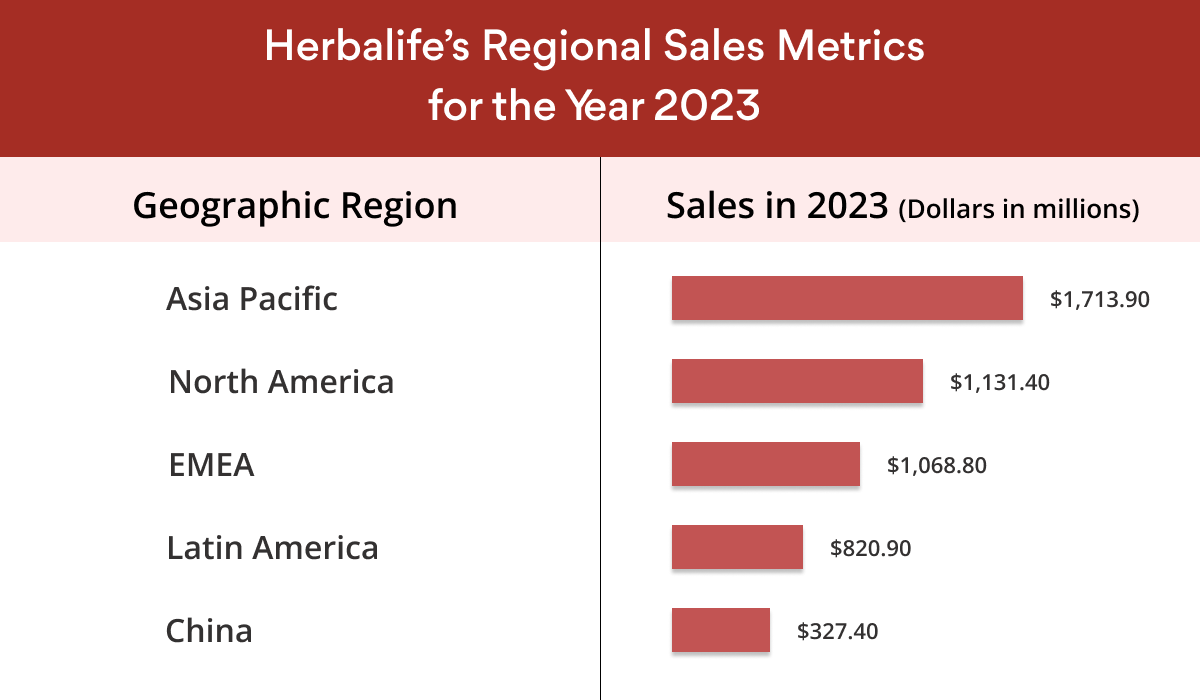
Impact:
- Herbalife’s best-selling product line, Formula 1 Nutritional Shake Mix accounted for approximately 26% of net sales in 2023.
- Herbalife’s targeted nutrition category contributed to 29.2% of their net sales in 2023.
- Herbalife’s operations in the Asia Pacific region contributed the highest revenue $1,713.90 million in 2023.
Natura &Co
Product: Natura &Co is a multinational cosmetics, personal care, fragrance, and beauty company.
Region: The company operates in over 70 countries but currently owns the largest market share among the leading cosmetics and personal care manufacturers in Brazil.
Impact:
- Latin America is the main revenue source for Natura &Co and accounts for 76.4% of its revenue, income, and cash generation.
- Natura &Co Latin America saw a 6.4% rise in net revenue in constant currency terms mainly driven by strong growth in the Natura brand in Brazil.
Utility Warehouse
Product: Utility Warehouse operates in a multi-service segment and offers a variety of essential household services, including energy (gas and electricity), broadband internet, mobile phone services, and insurance (home, car, and boiler cover).
Region: The company primarily operates in the United Kingdom.
Impact:
- UW experienced a significant acceleration in the growth of services supplied, with an increase of 533,239 services.
- UW’s electricity segment generated $1322.27 million in revenue, leading the revenue charts.
- UW’s gas segment brought in $1119.37 million in revenue.
eXp Realty
Product: eXp Realty is known for their real estate services, including buying, selling, and renting residential and commercial properties.
Region: eXp Realty’s North American segment operates in the U.S and Canadian residential real estate markets. And the International Realty segment operates in the U.K., Australia, South Africa, India, Mexico, Portugal, France, and several other countries.
Impact:
- eXp Realty's North American segment generated 98.6% of their total consolidated revenues in 2023.
- International Realty segment accounted for 1.3% of their total consolidated revenues in 2023.
Coway
Product: Coway is an international manufacturer of household appliances, water purifiers, air purifiers, bidets, water softeners, and mattresses.
Region: The company operates primarily in South Korea, but it also has a presence in various other countries, including the United States, Europe, Malaysia, Thailand, Indonesia, and China.
Impact:
- Coway’s flagship water purifier model, ICON, reached a significant milestone by surpassing 1 million units in cumulative sales and contributed to the growth of their domestic health appliance business.
- Coway’s Thailand subsidiary shows a strong growth, 27.6%, that highlights the potential for further regional expansion.
Primerica
Product: Primerica mainly offers insurance, investment and financial services.
Region: The company has a strong focus on operations in the United States, Canada, Puerto Rico and Guam.
Impact:
- Primerica’s Term life insurance continued to be the primary revenue segment, contributing 60% ($1.68 billion) to their total revenue in 2023.
- Primerica's offerings also include investment and savings products, which account for 31% of their portfolio.
Sunrun
Product: Sunrun's core product is solar energy, with a growing focus on integrated battery storage solutions.
Region: The company operates in 23 states, the District of Columbia, and Puerto Rico.
Impact:
- Sunrun installed 258.2MW of new solar capacity in Q3 2023, marking a 131% year-on-year increase in energy storage installations.
- Sunrun reached nearly 136,000 customers, with 84% opting for their subscription offering, which provides energy to customers under long-term agreements.
- Sunrun’s attachment rate in California is above 85%, which shows the company’s capacity to grow its storage business in a mature and profitable market.
Betterware
Product: Betterware offers a variety of household and cleaning products, kitchenware, home decor, and outdoor and garden accessories.
Region: Betterware primarily operates in Mexico and may also have distribution channels in other Latin American countries.
Impact:
- Betterware saw 44% of its revenue coming from the Home Organization segment in 2023, emphasizing product innovation with a unique two-tier sales model.
- Betterware’s Beauty and personal care segment (JAFRA) contributed 56% of its revenue in 2023 through a multi-level sales approach spanning generations.
- Betterware has a market cap of more than $643 million and is expanding its operations to the U.S. market.
Key investment areas of leading direct selling companies
This section discusses how top direct selling companies have focused their investment strategies. As a small to mid-level MLM company, you can take cues from these insights to align your focus accordingly.
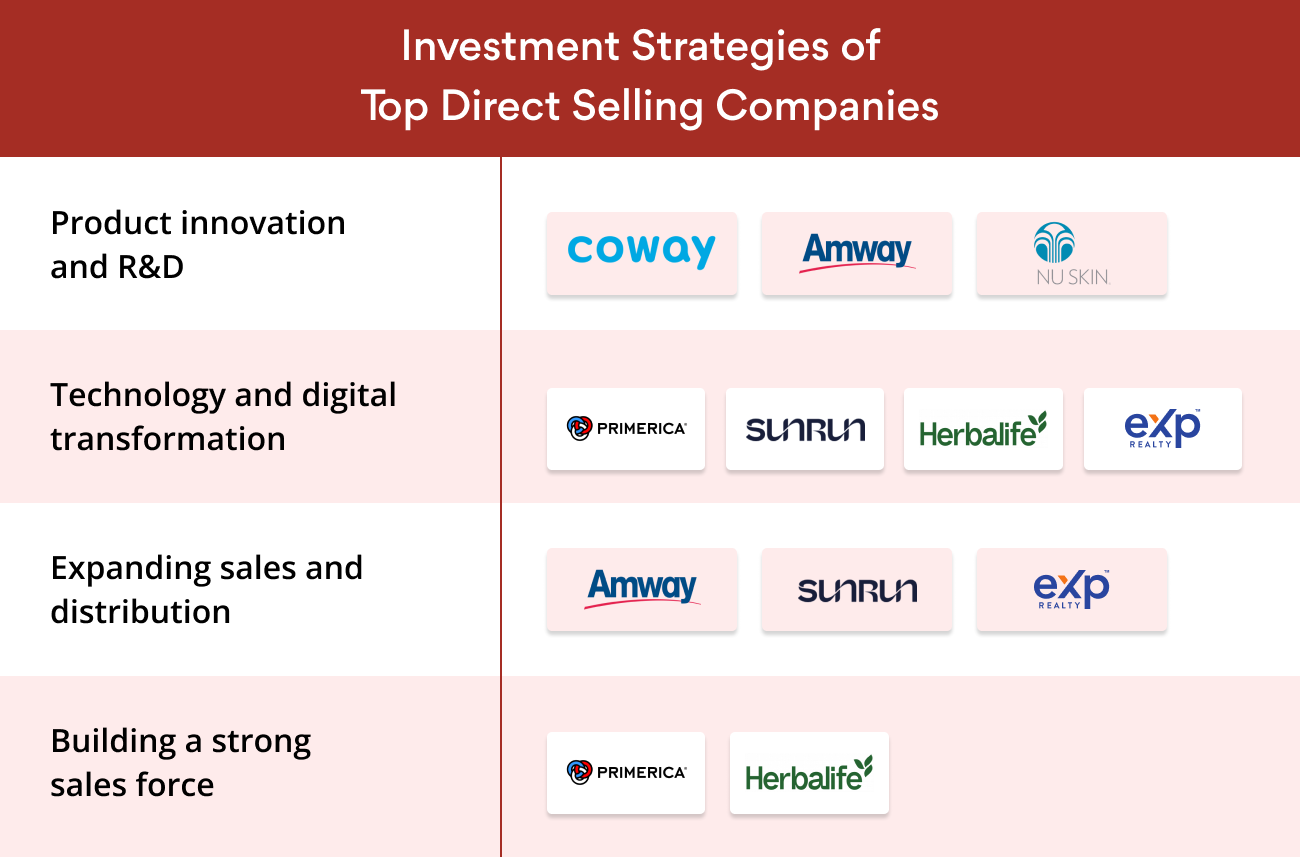
1. Product innovation and R&D
Coway is investing in research and development to create new and innovative products. This step secures their spot as a global leader. Their focus on the BEREX brand, which specializes in sleep and healing care, marks a long-term investment in the health and wellness sector and serves as their new growth engine.
Amway is directing its investment efforts toward product research and development, particularly in the nutritional products sector in the U.S. Moreover, they're meeting the rising demand for comprehensive health and wellness in China.
Nu Skin’s investment in a new manufacturing facility in China shows their area of focus in enhancing production capacity and responsiveness for their product lines.
2. Technology and digital transformation
Primerica is all set for ongoing development of proprietary tools and technology for their salesforce. So, their objective is to streamline administration and facilitate sales and growth.
Sunrun’s main focus is on enhancing customer value through technology. They use initiatives like battery retrofit programs and new retail partnerships.
Herbalife is keen on investing in business intelligence tools and technology infrastructure. They’re leveraging data analytics to identify growth opportunities and enhance both distributor and customer experiences.
eXp Realty has a strong tech backbone, continuously investing in developing cloud-based transaction platforms and technological products to ensure a more efficient and consumer-friendly experience.
3. Expanding sales and distribution
Amway is developing a robust supply chain system which is crucial for expanding their reach and ensuring product availability.
Sunrun is placing a strong emphasis on strategic partnerships and initiatives, such as early renewal programs, to expand their service offerings and reach new customers.
eXp Realty aims to invest in robust sales and marketing efforts to grow their membership base, attract subscribers, and acquire new clients.
4. Building a strong sales force
Primerica empowers its sales representatives with technology tools to increase productivity so that more time is dedicated to revenue-generating activities.
Herbalife's potential investment in technology to enhance the experience for members and customers could indirectly support their sales force.
The takeaway?
‘Where to start?’ and ‘How to succeed?’ These two fundamental questions often leave businesses of all sizes trapped in an ongoing cycle of uncertainty. Though every year organizations churn out hundreds of thousands of strategies, most of them fail to achieve their full growth potential.
Enter the concept of a growth strategy and how leading direct selling companies have fully embraced it:
- Breaking into new markets
- Developing new products
- Expanding the reach
- Diversifying offerings
So, with our data study we’ve achieved the point of making you understand how a strategic approach to growth can set you apart from the pack and keep your customer coming back for more.
But again, we do have potential white space on the horizon, so stay tuned for what's next!









Leave your comment
Fill up and remark your valuable comment.